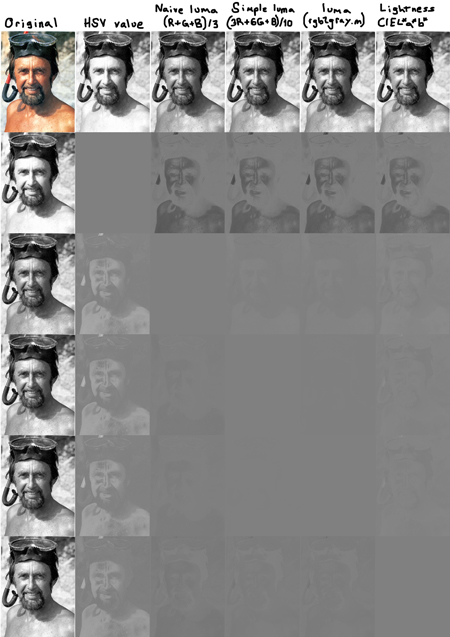Lightness vs luma vs grayscale vs value
Alec Jacobson
May 17, 2013
In image processing it's typical to convert an RGB input image into a more meaningful colorspace. For example it's often argued that distances in CIE L*a*b* colorspace are better correlated with perceived differences. Other times people simply use luma (aka luminance). I want to see how different these are. Here's a small MATLAB script to generate and compare different grayscale images:
im = imread('hans-hass.jpg');
imd = im2double(im);
% NTSC luminance == Matlab RGB2GRAY gray
% [Levin et al 2004]
ntsc = rgb2ntsc(im);
% L*a*b* lightness
% http://stackoverflow.com/a/6013156/148668
% ~[Lischinski et al 2006]
lab = im2double(applycform(im,makecform('srgb2lab')));
% HSV value
hsv = rgb2hsv(imd);
% simple rgb3gray
simple = imd(:,:,1)*0.3 + imd(:,:,2)*0.6 + imd(:,:,3)*0.1;
% Very naive rgb3gray
ignorant = sum(imd,3)/3;
% matrix of differences
row = [hsv(:,:,3) naive simple ntsc(:,:,1) lab(:,:,1)];
col = [hsv(:,:,3);naive;simple;ntsc(:,:,1);lab(:,:,1)];
diff = 0.5*kron(ones(5,1),row)+0.5*(1-kron(ones(1,5),col));
comp = [imd repmat(row,[1 1 3]);repmat([col diff],[1 1 3])];
imshow(comp);
This produces an array of comparisons:
 Some interesting things I noted were that the different implementations of luma are quite similar and they're all not so far from lightness. HSV value (the maximum of RGB) not surprisingly is very different.
Some interesting things I noted were that the different implementations of luma are quite similar and they're all not so far from lightness. HSV value (the maximum of RGB) not surprisingly is very different.
 Some interesting things I noted were that the different implementations of luma are quite similar and they're all not so far from lightness. HSV value (the maximum of RGB) not surprisingly is very different.
Some interesting things I noted were that the different implementations of luma are quite similar and they're all not so far from lightness. HSV value (the maximum of RGB) not surprisingly is very different.